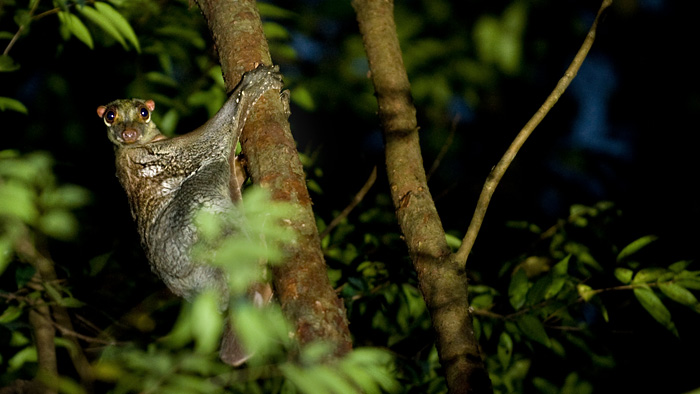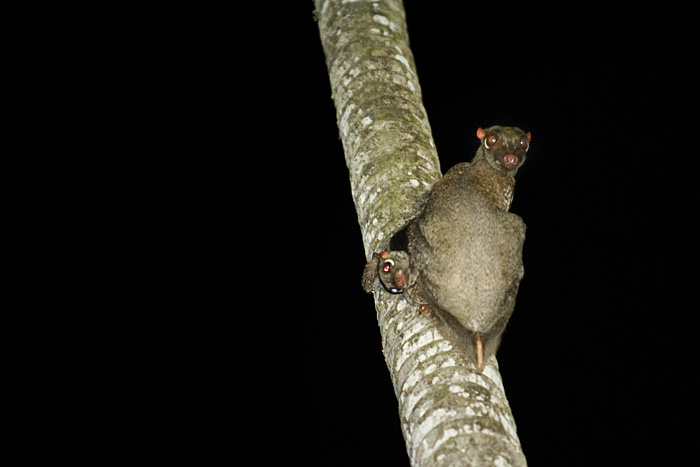Colugos from Singapore
Benjamin Lee has a very interesting Job. He works for the Singapore National Parks Board. He is responsible for maintaining the tree cover in town and also the National parks and watersheds. I was introduced to Ben as he was the best person to show me Colugo in the wild in Singapore.
He called me last evening and said he has a very special surprise for me. A Colugo had entered one of the buildings next to the park and we had to go pick it up and release it back in the national park. It was dropped off at the zoo and we picked it up and drove to Bukit Timah Nature Reserve.
Colugo, also known as the flying lemur is one of the weirdest creature on earth. Its has a very weird skin, a strange membrane around the animal and is the most capable gliding mammal on earth (after bats of course). I first saw it in a David Attenborough documentary and been wanting to see it even since. The amazing thing about this mammal is that it can never stand on the ground like the bats, and can only glide for locomotion.

Colugo Cynocephalus volans
We reached the National park at 6:30pm and was just about the right time to release the Colugo. Since it was in a box, I didnt see it too well. We took it to a large tree and released it. Just as we opened the box, it leaped on Ben, and then jumped onto the bark of the tree and ran up. After going up, it disappeared. It took us a fraction of a second to realise that it has gone airborne. It was one of the most wonderful sights on earth to see as it glided to a large ficus tree a good hundred meters away.
We got back to the office and then started searching for the resident Colugos. Today it was not there on the tree which it’s usually found. After a bit of searching, I suddenly heard a ‘thud’ on a tree next to me and then realised it was Colugo which landed on a tree very close to me. I whipped my camera out and shot the photograph below. I made sure I did not use a flash and shot this only with a torch light.

Philippine Colugo Cynocephalus volans (Nikon D700 with 70-200mm | 1/25 sec at f/2.8 @ ISO 2000)
This disappeared into the canopy and soon after, we bumped into the team from the National Parks who were doing their monthly night survey of the park. They invited me to join and I was more than happy to go along. I was just not prepared for the humidity, but the next 4 hours of walk through the forests was amazing. We saw the Long-tailed nightjar, Common Palm civet, Red-cheeked Flying Squirrel, Malayan Giant frog and dozen of amazing rainforest trees in bloom.

Colugo carrying a young one
Along the trek, we also spotted 3 more Colugos and this one was carrying its young one along with it. We all got back late night, had a data sharing meeting and called it a day. It was excellent to survey a new forests and was quite happy to have identified most of the species myself.
I strongly hope, other big cities learn from Singapore (and New York) on how to manage urban forests. Even if they don’t care about the tree cover, at least realise that unlimited clean water supply can only come from the watersheds that these forests provide.
wow ………soo many animals n birds never seen b4 ..got to see a lot through ur eyes …thnk ya for tht .
I had no clue such a species existed Kalyan. This was a wonderful experience for you I am sure. Lovely photographs! Thanks for sharing 🙂
you are lucky kalyan….you go visiting family and still end up in new forest territory and photographing new species… nice article by the way….TFS….
Crazy Beautiful!!
Really nice and the your story makes it nicer!
Lovely reading and excellent pictures!
Hey what a pic to get on your family trip, amazing, thanks for showing a new species, wonderful. Wonderfully narrated, thanks for sharing.
This is Just Awesome
How great that you didn’t use the flash
Dear Kalyan your work have always inspired us.
I have always wondered what it look like in actual, have read about it in my zoology textbooks but never seen a real one…nice writeup ..thanks for sharing
Kalyan,
Even in a plastic town like Singapore you end up getting pictures of a species we did not even know existed. And in torchlight you take better pictures than we do in broad daylight. Awesome!
Another awesome post. I love the way you always capture the mood & emotions in your pictures. And there is always some learning too 🙂
Do you ever use the “auto” setting for your camera (assuming you have one) when you have to take
a very quick shot ? If not, how long does it take you to get the settings right ?
Never actually. There is no such thing as getting the setting right.. every shot you take will need a diff setting to suit the need. The job of a photographer is to understand the light and the quality of the light and determine the best settings to capture that light in the way you want to capture it.
I understand. What really amazes me is the speed that is required to get the settings right for
the given conditions, especially when the window of opportunity to take the shot may be only a few seconds. I was wondering if there are any ways to reduce this response time. For example, when you know that you’re going to shoot in torchlight, do you preset your ISO settings,exposure times and shutter speeds to shoot in low light, and then adjust to the best settings for the given situation when you actually sight the animal ?
I usually go by the light. Keep changing the ISO every half hour or so. I almost always shoot in aperture priority with the highest aperture (lowest f value) and then depending on what I am shooting, I keep changing the exposure compensation depending on scene to scene.
Atish, I know Kalyan has answered you and I am no professional photographer, so take this with a pinch of salt. The premise of your question is that you will have to make a quick shot- thats something will jump on you unexpected, out of the blue and you will have to simply point and shoot and I have a problem with that. I realise this can happen time to time to amateurs (and perhaps happens to me all the time!) but if you are a good professional photographer this should not be happening at all or if at all at a very minimum. Pardon me for saying this, if something jumps on you, then you are not prepared and do not know your subject. This is true of wedding photographers(“the ring”, “the kiss”, “the knot”, “arundathi” and the rest of the murari cant be somethign that sneaks upon you) as it is equally true of wild-life photographers who know their subject and its behaviour(the ensuing fight among the big cats after a kill should not be a surprise for a photog). This is not to say no should be surprised ever but it should be an exception and not a rule. My point would be that your settings, focus etc cant so drastically off the charts to your surroundings in which you are in and tuned into the behaviour of your subject. And at the top of her game a photographer is shooting ahead of the moment, anticipating and prefocussing the shot- the exposure, the focus and the composition is all ready and the subject just walk into the trap at the right moment! Thats the magic.
Bhooshan, I agree. While there is always an element of randomness to wildlife photography, the best practitioners seem to mimimise this through anticipation. Kalyan, in his reply, brought up the anticipation of the light conditions. You brought up another key skill – anticipation through jungle craft. Thanks to both you and Kalyan for taking the time to respond to my questions. I learnt something here.
That makes sense. The results speak for themselves, as we can all see ! Thanks for sharing, Kalyan.
Lovely Kalyan. I remember my visit to Singapore and being amazed at the rainforest cover they preserve for their water supply. Rightly pointed out that we should learn. How I wish our Indian cities learnt this aspect from Singapore than (or in addition to!) trying to ape it in terms of its urban infrastructure only. Was also reading through your response to AtishG above and learnt a few nice tips 🙂 Thanks for sharing such lovely stuff – the images, the writeup and the tips 🙂
Hey Kalyan,
Great article and shots. I was hoping to get lucky with Colugos myself over the last couple of years myself as I spent a fair amount of time in Singapore and Indonesia (Borneo). I remember the staff at the night safari park telling me they were found in the area and though I tried in vain I only ended up seeing a rat cross my path. I did manage to see a very interesting sight of a Changeable Hawk Eagle (white phase) perched atop a tree next to the road in the evening watching the Jurong traffic go by underneath it. A good example of preservation of city forest as you say and you can really see its expanse and connection to Johor in Malaysia when you fly above the place. If I do go back there one day I’ll definitely appreciate the contact of the person from the National Parks service who took you to try and see the Colugos and other wildlife of the area because it would be so worth it.
Once again Amazing Shots man and lovely to read about it as usual.
Sameer
Hey Kalyan,
Did you see or hear any Tokay Geckos or Giant Forest Geckos (they sound pretty similar, and are the same size but have different patterns) while you were walking in the Bukit Timah Forest? Do they also report Draco over there as well? Flat headed cat? Leopard Cat?
Thanks and Regards
Sameer
Nope. Was hoping to see them but did not. They used to have leopard cats it seems.. but now they are out. They think the flat headed cat is also very rare in malaysia as well these days. Draco is very much there.. but again I missed it 🙁
Unless things have changed in recent times, I think Singapore buys its water from Malaysia. They spend a lot on desalination and the tree cover is not enough watershed to meet their demands. New York is the best example of choosing to preserve its watershed in the Catskill Mountain than go for expensive but equally challenging engineering solutions to secure its water supply.
Fantastic stuff Kalyan. Do you remember which documentary of Attenborough? One of Life series?
wow, first timer for me.
Beautifully captured with narration.
TFS.
Love ur journal.
That sure is a wierd looking creature, with that shiny membrane over entire body, arms and even tail. Very wierd. Thanks for sharing!